There are 6 major types of Operating System which are given below,
1. Batch Operating System
Users of batch OS cannot interact with the computer directly. So, Each user puts his job on an offline device like punches cards and submits it to the computer operator. Then by computer Operator, same type of processes are grouped together and treated as a batch.Such types of operating system was use earlier. Lets explain with diagram given below,
Advantages Of Batch OS
- If a job takes a very long time(1 day or so) Then, such processes can be executed even in the absence of any humans. thus, such operating systems are very useful in some cases i.e. same type of bank statement.
Limitations Of Batch OS
- Suppose I/O or an error occurs in one process of a batch. Then, all the remaining process gets affected. They have to wait until the I/O completed or error is resolved.
It follow FCFS algorithm. There may be a possibility of short process have to wait for long time due to execution of heavy process first.
Examples of Batch Operating System are Payroll System, Bank Statements etc.
2. Time Sharing OS
In general, when a process starts executing on CPU, it will occupy the CPU till its completion. But, Sharing of CPU among the different users or processes for quantum period of time is called time sharing OS.
CPU scheduling Algorithms are used for CPU Sharing .This short period of time during that a user gets attention of the CPU is known as time slice or time Quantum. Each process from user is given some time to execute, so that all the processes work properly.
Due to so fast Context switching, it looks all processes are running at the same time on CPU. But in real, each task gets time of CPU as they use single system.
Time Sharing is a multitasking but explained in two different terms.
But the concept is the same in both terms. Have a look
Single user time Sharing OS
Time sharing is a method where the resources like CPU, Main memory are shared among the different tasks at the same time by means of multi-programming and multi-tasking is called time sharing Operating System.
Multi user time Sharing OS
Time sharing is a method where the resources like CPU, Main memory are shared among the different users at the same time by means of multi-programming and multi-tasking is called time sharing Operating system.
Advantages of Time sharing operating systems
- Provide quick response.
- Each task gets an equal opportunity
- Reduces CPU idle time.
- Avoid duplication of software because OS manage all the users and resources properly.
Disadvantages of Time sharing operating systems
- Problem of reliability due to Context Switching
- Some data security issues
- Data communication problem
3. Distributed Operating System
It is a model where different computer are running parallel linked by communications links. It use multiple CPU’s to execute multiple processes. Multiple processors communicated with each other through multiple communication lines i.e. buses, chips or something else. It is also consider as loosely coupled OS . An individual CPU called as a node, Site or Computer.
Advantage of distributed operating system:
- As all systems are independent so, Failure of one will not affect the other system in same network,
- Highly speed due to shared network.
- Load on host computer reduces because no system is dependent to other.
- Delay in data processing reduces.
Disadvantages of distributed operating system:
- Fault tolerance
- Mutual exclusion
- Time in clock synchronization
4. Network Operating System
it mostly Runs on server computer. Server is just a program which runs on particular computers called Server Computers. It provides the capability of manage data, application, user, group, security, and other network functionalities. There are different types of Network Operating System (Servers) and each having its specific task. Explained under, A server is a computer serves data to other computers. Server computers are available in the form of local area network (LAN) and wide area network (WAN).
Some Example of LAN
- at Home
- at Office
- Network for small business
Some Example of WAN
- Web Servers: A Web server hosts websites on the internet.
- Mail Servers: Mail server is responsible for sending and receiving mails over network
- File Servers: a file provides access to files at a specific storage location that can be accessed by multiple users in that network.
Concept is that:
When you connect to a file server on at office, it appears as a hard disk on your computer. You can browse the directories just like local folders at node computer. If you want to copy a file from the server System to your computer then simply drag it to your folder on your local disk.
In the same way all resources of Server computer like Printer can easily be used by its terminals.Allow to shared file and printer access among multiple computer in the network
Example of Network OS
- Microsoft window server 2003
- Microsoft window server 2008
- Unix
Note: we can use Network operating system on our PC or laptop and it works properly. But we can’t use its full functionality. That’s why we used it on server computer.
Advantages of Network Operating System
- Security Can easily managed because we have to focus on running process.
- easy to upgrade the Technology and software
- Remote access enabled: user can access the server from any location by logging in without going to server actual location.
Disadvantage of Network Operating System
- High cost: high organizations use this server according to their needs i.e Armed force, banking etc
- Dependency on central location for most of the operations
- Regular maintenance and update.
5. Real time Operating System
- Process time: Time taken by OS to process the task
- Response time: Time interval between inputs to output by Operating system .Time interval to respond the inputs is also called Response time and it is very small interval.
Real time system is used when there are time constraints are very strict like medical system, missile systems, robots, etc.
Some examples of real time OS
- missile systems
- weapon systems
- control systems
- traffic control signals
- medical system
- Scientific experiments
- robots
- air traffic
- Industry control system etc.
There are Two types of Real Time OS
1. Hard Real-Time Systems:
Task must complete on time. In Hard Real Systems time requirements are very strict and even the minor possible delay is not acceptable. These OS are specific for saving life like medical system, traffic control signals etc
2. Soft Real-Time Systems
In these OS Task completion is the most priority and time constraints are not too strict.
Advantages of RTOS:
- Error Free: Real time Operating Systems are error free.
- Memory Allocation Management: Memory allocation is best and very easy to manage in these types of systems.
- Task Shifting: In earlier Systems, task shifting was considered 10 micro seconds but now it reduced to 3 micro seconds.
- Focus on Current Application: current running applications are considered at top priority rather than applications which are in queue.
Disadvantages of RTOS:
- Limited Tasks: Very few tasks run at a time.
- Costly: by using the heavy system resources Sometimes leads toward out of budget.
- Complex Coding and Algorithms: Coding and designing of algorithms are very difficult to write on.
- Difficult to task switching: Each Task in the Queue executes according to his priority. It is difficult to change them at run time.
so, in desktop/laptop Os the windows Os is on top.
6. Mobile Operating System
What is a Mobile Operating System (Mobile OS)?
As Windows, Linux and Unix OS are control the PC and laptop. In the same way, there are lot of mobile operating systems are available, which are used to control the functionality of mobile phone and tablets. Mobile OS also control the mobile apps on your device to extend the functionality of your device.
Types of Mobile Operating Systems
You must know about the operating system of that particular device, before to purchase it. List of some Mobile operating systems is here,
- Symbian OS (Nokia)
- iPhone OS / iOS (Apple)
- Bada (Samsung Electronics)
- Windows Mobile (Windows Phone)
- MeeGo OS (Nokia and Intel)
- webOS (Palm/HP)
- Series 40 OS (Nokia)
- BlackBerry OS (Research In Motion)
So, in mobile operating systems Nokia(Symbian) is on top.
Overall Comparison Between Laptop/PC and Mobile OS
According to Wikipedia in in 2020, The following image shows the Web results from various resources of different types of operating system.
Hence proved, OS of mobile is more using than PC/Laptop.
Multi-Programming Vs. Multitasking
What is Multi-Programming?
Multi-programming is an early form of parallel processing, in which several programs are run at the same time on a single processor (uni-processor).
It is a Non preemptive where CPU execute the entire process before to execute the next waiting process. But the condition is that, if running process request for any I/O or external interrupt is occur during that process execution. Then CPU will block that running process and move to that particular interrupt.
Let’s explain with Example
let suppose, there are three Processes P1, P2, and P3. And their time of execution is 10, 15 and 05 respectively. Then P1 completely execute from time 0-10. Then P2 execute from time 10-25. And in the last P3 will execute form 25-30 time period. Keep in mind, there is no interrupt occur while execution of these processes. If it happened then CPU move to that particular interrupt. Explain in diagram given below,
Advantages of multi-programming systems
- CPU Utilization is maximum because CPU never become idle due to Less context Switching.
- Memory and Resources are managed easily because of non-preemptive.
- It support multiply users
- Short time jobs are executed early than long time jobs.
Disadvantages of multi-programming systems
- Less the Response time.
- Due to non-preemptive, long time jobs have to wait long
- To handle all processes is sometimes difficult.
What is Multitasking?
Multitasking works through preemptive mode where every process executes for some period of time. This time is also called Quantum period.
Condition will be same as for multi-programming that, if process request for I/O, or any external interrupt is occur during that process execution. Then CPU will block that running process and move to that interrupt Handler.
In the modern OS, we are able to play music, writing in Microsoft Word, Google Chrome and many more process simultaneously. This is achieved by means of multi-tasking.
Let’s explain with Example.
If there are three Processes P1, P2, and P3. Their time for execution is 10, 15 and 05 respectively. And Quantum period of all processes is 05. Then P1 will execute from time 0-5. P2 will execute from time 5-10.And P3 will execute form 10-15 time period. Still only P3 complete its execution. No P1 will execute from time 15-20 for its remaining execution time. In the same way P2 execute form time 20-30. Keep in mind, there is no interrupt occur while execution of these processes. If it happened then CPU move to that particular interrupt.
Advantages of multitasking:
- Highly Response Time
- Saves time ,Saves money
Disadvantages of multitasking:
- CPU sit idle due to Highly Context switching
Types of Multitasking
- Process based multi-tasking
- Thread based multi-tasking
Multi-programming vs. Multitasking
Now look at the comparison, multi-programming vs. multitasking
| Multi programming | Multitasking |
| Non preemptive | Preemptive |
| It was early used | It used now a days in Laptops and PC |
| Less Context Switching due to non-preemptive mode | Highly Context Switching due to preemptive mode |
| Non Responsive | Highly Responsive |
| No time sharing | Time sharing |
| Main target: CPU utilization because of less Context Switching. | Main target: Responsive because of Highly Context Switching. |
Note: Multi programming, multitasking, multi-threading are execute on single CPU or multiple CPU’s. But Multiprocessing only execute on multiple CPU’s.
Multi-Programming Vs. Multitasking
What is Multi-Programming?
Multi-programming is an early form of parallel processing, in which several programs are run at the same time on a single processor (uni-processor).
It is a Non preemptive where CPU execute the entire process before to execute the next waiting process. But the condition is that, if running process request for any I/O or external interrupt is occur during that process execution. Then CPU will block that running process and move to that particular interrupt.
Let’s explain with Example
let suppose, there are three Processes P1, P2, and P3. And their time of execution is 10, 15 and 05 respectively. Then P1 completely execute from time 0-10. Then P2 execute from time 10-25. And in the last P3 will execute form 25-30 time period. Keep in mind, there is no interrupt occur while execution of these processes. If it happened then CPU move to that particular interrupt. Explain in diagram given below,
Advantages of multi-programming systems
- CPU Utilization is maximum because CPU never become idle due to Less context Switching.
- Memory and Resources are managed easily because of non-preemptive.
- It support multiply users
- Short time jobs are executed early than long time jobs.
Disadvantages of multi-programming systems
- Less the Response time.
- Due to non-preemptive, long time jobs have to wait long
- To handle all processes is sometimes difficult.
What is Multitasking?
Multitasking works through preemptive mode where every process executes for some period of time. This time is also called Quantum period.
Condition will be same as for multi-programming that, if process request for I/O, or any external interrupt is occur during that process execution. Then CPU will block that running process and move to that interrupt Handler.
In the modern OS, we are able to play music, writing in Microsoft Word, Google Chrome and many more process simultaneously. This is achieved by means of multi-tasking.
Let’s explain with Example.
If there are three Processes P1, P2, and P3. Their time for execution is 10, 15 and 05 respectively. And Quantum period of all processes is 05. Then P1 will execute from time 0-5. P2 will execute from time 5-10.And P3 will execute form 10-15 time period. Still only P3 complete its execution. No P1 will execute from time 15-20 for its remaining execution time. In the same way P2 execute form time 20-30. Keep in mind, there is no interrupt occur while execution of these processes. If it happened then CPU move to that particular interrupt.
Advantages of multitasking:
- Highly Response Time
- Saves time ,Saves money
Disadvantages of multitasking:
- CPU sit idle due to Highly Context switching
Types of Multitasking
- Process based multi-tasking
- Thread based multi-tasking
Multi-programming vs. Multitasking
Now look at the comparison, multi-programming vs. multitasking
| Multi programming | Multitasking |
| Non preemptive | Preemptive |
| It was early used | It used now a days in Laptops and PC |
| Less Context Switching due to non-preemptive mode | Highly Context Switching due to preemptive mode |
| Non Responsive | Highly Responsive |
| No time sharing | Time sharing |
| Main target: CPU utilization because of less Context Switching. | Main target: Responsive because of Highly Context Switching. |
Note: Multi programming, multitasking, multi-threading are execute on single CPU or multiple CPU’s. But Multiprocessing only execute on multiple CPU’s.
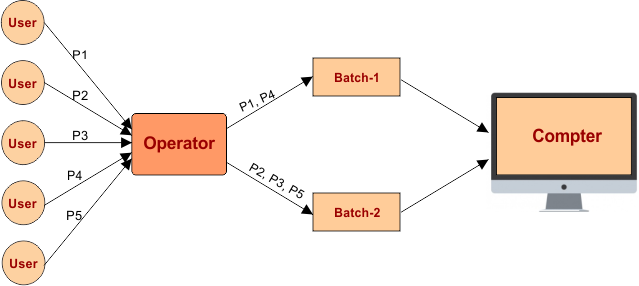
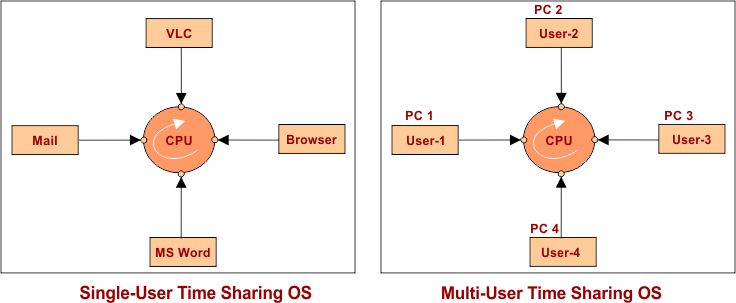

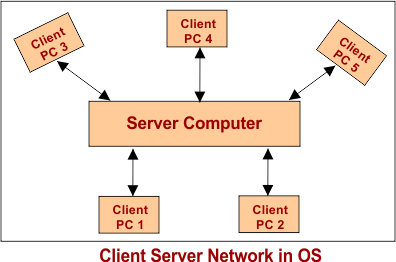
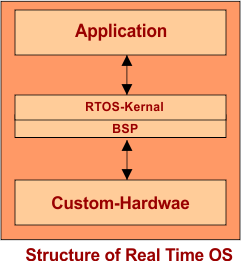


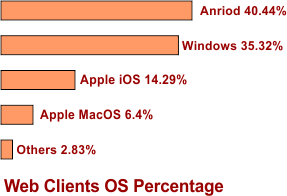


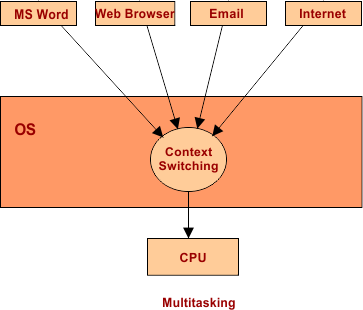





No comments:
Post a Comment